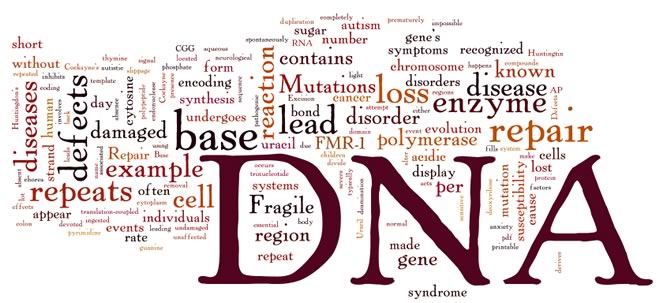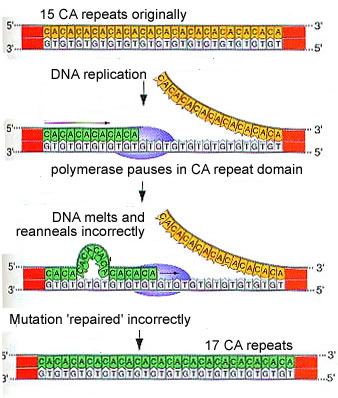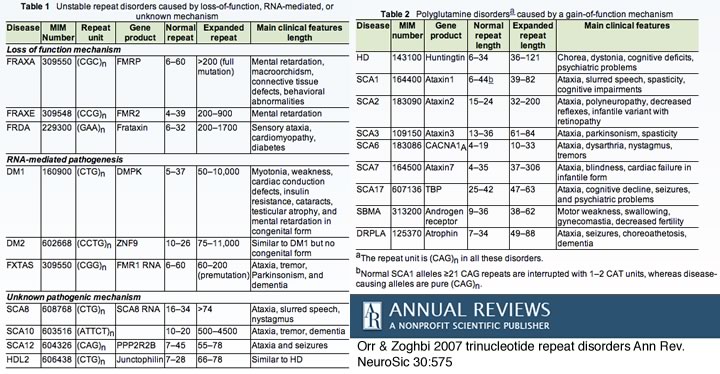|
20. Mutations, Deletions, Duplications & Repair
|
Tweet |
|
|
 |
Repairing damaged DNA: Mistakes are made during DNA synthesis and DNA can be damaged by environmental factors, which include radiation, ingested chemicals and reactive compounds made by the cell itself. Moreover, in aqueous solution DNA is not particularly stable. |
|
For example, cytosine can react with water, which is present at a concentration of ~55 M inside a cell. It undergoes a deamination reaction to form uracil. |
 |
|
Uracil is not normally found in DNA, so its presence can be easily recognized as a mistake by the enzyme uracil-DNA-N-glycosidase [link]. This enzyme severs the tie between the base and the deoxyribose group. This reaction is similar to a process that occurs spontaneously, that is without an enzyme. The bond between the base and the sugar can be hydrolyzed and the base lost. |
|
|
This reaction leads to depurination - the loss of an cytosine or thymine group, or depyrimidination - the loss of an adenine or guanine group. The reaction rate is increased at acidic pH, which is probably one reason that the cytoplasm is not acidic. How frequent is this event? A human body contains ~1014 cells. Each cell contains about ~109 base pairs of DNA. Each cell (whether it is dividing or not) undergoes ~10,000 base loss events per day or ~1018 events per day per person. That's a lot! |
The absence of a base, due either to spontaneous loss or enzymatic removal, acts as a signal for the enzyme AP (absent purine/absent pyrimidine) endonuclease [OMIM]. An endonuclease is an enzyme that catalyzes the breading of a bond between nucleotide moieties within a nucleic chain; an exonuclease catalyzes the breaking of the bond that connects the terminal nucleotide moiety to the nucleic acid chain. A 5' exonuclease cuts the nucleotide off the 5' end of the molecule, a 3' exonuclease, off the 3' end. |
A DNA polymerase binds to the open DNA using the undamaged strand as a template and fills in the gap. This general system is known as Base Excision Repair. In the human genome there are over 130 genes devoted to repairing damaged DNA. [video with lots of misspelled words]. |
|
|
|
|
|
Mutations and evolution: Mutations are the ultimate source of genetic variation - without them evolution would be impossible. Mutations can lead to a number of effects, and they can create new activities. At the same time these changes may reduce the activity of an important gene. |
 |
| Such "molecular level" conflicts could greatly limit evolution. This problem is avoided by the fact that genomes are not static, there are processes of gene duplication and genome rearrangements that occur continuously. Such events even occur during embryonic development, not all cells in your body have exactly the same genome. [link][link] |

|
|
| Mutations and human disease [Genes & Disease handbook] |
 |
While they are essential for evolution, defects in DNA synthesis can lead to a number of diseases. For example, let us consider the trinucleotide repeat disorders. These diseases are caused by slippage of DNA polymerase and the subsequent duplication of sequences. There are a number of "triplet repeat" diseases, including several forms of mental retardation, Huntington disease, inherited ataxias, and muscular dystrophy. When these "slippable" repeats occur in a region of DNA encoding a protein, it can lead to regions of a repeated amino acids. For example, expansion of a domain of CAGs in the gene encoding the polypeptide Huntingtin causes the neurological disorder Huntingdon's chorea. |
|
|

|
|
|
Fragile X: This replication defect is the leading form of autism of known cause. Sadly, there are many forms of autism in which the cause is not known. Only about 6% of all autistic individuals have fragile X. Fragile X can also lead to anxiety disorders, attention deficit hyperactivity disorder, psychosis, and obsessive-compulsive disorder. Because the mutation involves the FMR-1gene, which is located on the X chromosome, the disease is sex-linked and effects mainly males (who are XY, compared to XX females). |
|
In the unaffected population, the FMR-1 gene contains between 6 to 50 copies of a CGG repeat. Individuals with 6 to 50 repeats are phenotypically normal. Those with 50 to 200 repeats carry what is known as a premutation; these individuals rarely display symptoms but can transmit the disease to their children. Those with more than 200 repeats typically display symptoms and often have what appears to be a broken X chromosome - from which the disease derives its name. The pathogenic sequence in Fragile X is downstream of the FMR1 gene's coding region. When this region expands, it inhibits the gene's activity. [recent review on the disease mechanism] |
|
Defects in DNA repair can lead to severe diseases and often a susceptibility to cancer. For example, defects in mismatch repair lead to a susceptibility to colon cancer, while defects in translation-coupled DNA repair are associated with Cockayne syndrome. [OMIN entry] People with Cockayne's syndrome are sensitive to light, short and appear to age prematurely. |
|
|
|
Genes and alleles: A gene is a region of DNA that encodes a gene product, together with the sequences required for its proper expression. Genes can overlap with one another, particularly in terms of their regulatory regions, and defining the full regulatory regions of a gene can be difficult. A gene's regulatory regions may span many kilobases of DNA and be located upstream, downstream, or both of the coding region. An allele then is any version of the gene that differs from another in terms of nucleotide sequence. Often the most common version of an allele is referred to as the wild type version. That said, there are often multiple common alleles in the population, and they all may be equally normal in terms of the phenotype(s) they produce (although more or less frequent). When we compare alleles, we think about the effects of differences on the expression and/or behavior of the gene product, but it is important to remember that most gene products work in concert with the products of multiple other genes, so the total set of alleles in an organism, its genotype, will determine its phenotype (together with environmental factors). |
|
Two alleles can produce quite similar gene products, or their products can be different. An allele can produce a gene product with completely normal function or absolutely no functioning product (referred to as a null or amorphic allele). It can have less function than the "wild type" allele (hypomorphic), more function than the wild type (hypermorphic), or a new function (neomorphic). Given that many gene products function as part of a multimeric complex and that many organisms (like us) are diploid, there is one more possibility, the product of one allele can antagonize the activity of the other - this is known as an antimorphic allele.These different types of alleles were defined genetically by Herbert Muller (who won the Nobel prize for showing that X-rays could induce mutations, that is, new alleles.) |
|
|
|
Questions to answer
|
|
|
Questions to ponder
|
|
|
|
| replace with revised beSocratic activity |
|
|
|
revised 10-May-2014
|